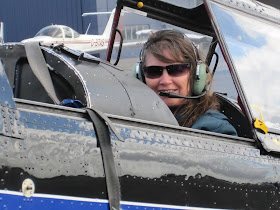 Halcyon days at Sherlowe; A Cessna 172 I used to have a share in. I'd been flying in the area and dropped in for a brew
Halcyon days at Sherlowe; A Cessna 172 I used to have a share in. I'd been flying in the area and dropped in for a brew(As usual, click on the images for larger size)
Sherlowe is the most delightful place to fly into. Not far from The Wrekin in Shropshire, south of the long disused High Ercall wartime airfield, this delightful strip has for the past eleven years been a haven for 'grass roots' aviators such as myself.
It was established by Bob Pooler at Lower Grounds Farm, and initially he had local opposition to the strip's existence. We helped him by lobbying the local planning authority, pointing out that this was no 'airport' set for expansion, it was a quiet grass farm strip and would always remain so. Bob won his planning permission, and Sherlowe became firmly established with many of us aviators who fly vintage or otherwise 'interesting' aeroplanes that don't need miles of tarmac to operate from as a delightful strip to visit. Bob built a clubhouse named 'Terminal One', which was fitted out with armchairs and all the comforts of home, including a fully stocked fridge, a microwave, sink, and of course, a kettle.
Many is the time I've been flying in the area and have dropped into Sherlowe, taxied up to Terminal One, switched off the blattering Gipsy major engine of our dH Chipmunk, slid back the canopy, and drunk in the rural peace of this lovely place. One could make a brew, even some lunch if appropriate (remembering to toss some money into Bob's 'honesty tin'), and sit out at one of the tables in front of Terminal One looking across to the farms and the nearby Wrekin and enjoying the rural peace.
But all good things come to an end, and today was the last day of operations of Sherlowe strip as we know it. The runway is grass, and over half of it is on land belonging to Bob's neighbour. This farmer has terminated the lease of the land to Bob and it will return to the plough, leaving the remains of the Sherlowe runway (at only 200 metres) to short for all but the most capable STOL (Short Take Off and Landing) aircraft, and helicopters.
Today was not only the final day of Sherlowe as a usable airfield, it was also a good flying day among a run of very wet and windy non-flying days (earlier this week has been horrid, and the forecast for the next few days is at least as bad). The Chipmunk was available, so I took the opportunity to pay a final visit to Sherlowe today.
Here's the strip from the north photographed this morning:

The part of the runway that is closed from today can be seen as a green stripe bisecting the brown ploughed field in the middle centre. The strip continues towards the aeroplane's position into the green field, terminating at the hedge at the end of the field. The farmhouse of Sherlowe, and 'Terminal One' can be seen on the left side of the field. That green part of the strip with the house and Terminal One is level, and is Bob's land (as ever, click on the picture, then click again to view the picture in detail). The far part of the strip where it continues as a green (actually, fading to yellow as it has been sprayed prior to ploughing) stripe across the adjacent ploughed field it slopes downhill and is his neighbour's land, and that is lost as from today.
The new strip will be on Bob's land, on the green field where the house and Terminal One are located, but oriented slightly more 'clockwise' that the present strip, to maximise available length across the field. It'll be about 300m, and more into the prevailing wind (present strip is 33/15).
Here is the Black Chippy this morning in front of 'Terminal One' at Sherlowe:

And here it is back at Liverpool keeping a fellow hangar resident (A Harvard) company. It had started as a lovely clear blue-sky day, but at Liverpool those gathering clouds were generating some very heavy showers by the time I left for home:

Maybe, when Bob has re-laid the strip, we might visit again, though 300 metres will be a challenging length on all but the days when a good wind is blowing directly down the runway!
























